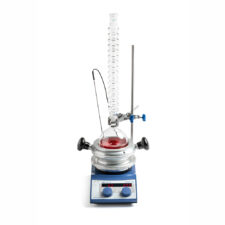With vestiges of both Christian and ancient Roman traditions apparently in the mix along with what was an effort to “Christianize” the pagan celebration of Lupercalia (a fertility festival dedicated to Faunus, the Roman god of agriculture, as well as to the Roman founders Romulus and Remus) it’s fair to say that the celebrations of Valentine’s day have changed a bit over the years.
These days the greetings card industry revels in beautiful/quirky/rude cards, the chocolatiers add extra flourishes to their packaging, and the florists hike up the price of red roses. (Note: if you fancy buying a DrySyn Classic Kit or some CondenSyn for your loved one we promise we won’t increase the price for Valentine’s!)
We found some fairly random things on a hunt around the internet for Valentine’s gifts for chemistry fans; an Oxytocin necklace, chemistry beaker wine glasses, chemistry cocktail mixer kits and loads of chemistry Valentine’s cards. The vast majority of the Asynt team appear to be quite chocolate orientated though so I wouldn’t be surprised if this featured heavily in their Valentine’s 2021 celebrations.
What’s chocolate got to do with love?
As well as the melt-in-the-mouth all round general gorgeousness of chocolate, we can’t think “chemistry of chocolate” without touching on (no pun intended!) the supposed aphrodisiac properties – but many of the Asynt team have cat and/or dog members of their family so we should also talk about its less favourable toxic attributes…
The most contemporary link to chocolate’s reputation as an aphrodisiac comes from a book written in 1983 by Dr Michael Liebowitz (a psychiatrist at Colombia University) in which he emphasised this property and linked it to the chemical phenylethylamine (PEA). This is found in relatively high concentrations in chocolate but unfortunately it’s broken down when ingested so unlikely to have any significant happy result! It does also contain tryptophan which is a substance associated with feelings of well-being but yet again, once it’s been digested very little remains so no chance of a “glow” up. Chances are then, that the whole aphrodisiac idea is no more than a placebo effect! Do we still love it? Of course!
The bad stuff:
Consumed by humans in the quantities we would usually (even after a bad break up), Theobromine (a stimulant compound found in chocolate) presents us with no issues but the same can’t be said for our canine friends. The darker the chocolate, the higher the concentration of theobromine and, for humans, the median lethal dose has been quoted by some sources as 1000 milligrams per kilogram of body weight. You’d need to eat a LOT of chocolate to poison yourself. For a person weighing in at 70 kg you’d need 70g of theobromine which would be in the region of 35kg of milk chocolate. I know a couple of people who can make a good effort when it comes to chocolate consumption but I don’t think it’s humanly possible to eat 35kg of it!
However for dogs the median dose is just 300 milligrams per kilogram of weight so if you’ve a dog weighing maybe 10 kg, just 3 grams of theobromine is needed to reach that dose – around 1.5kg of milk chocolate. But if you swapped that creamy milk chocolate out for some fancy gourmet dark chocolate which can be as high as 600 milligrams per 100 grams, our furry friend need only eat around 500 grams. The disastrous digestive side effects of the poison would be occurring before this was reached in theory but I know my dog eats pretty fast when he hears someone coming and he’s found something tasty all alone and undefended.
So if you’re giving a chocolate gift this year for Valentine’s just make that only the humans get their hands on it! And possibly send some to your Asynt friends so we can share the love – but not Asynt’s Head of Security, Petal who is very partial to sharing a bag of crisps when given the opportunity!









